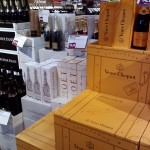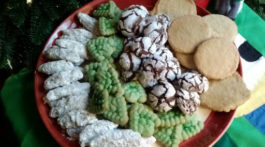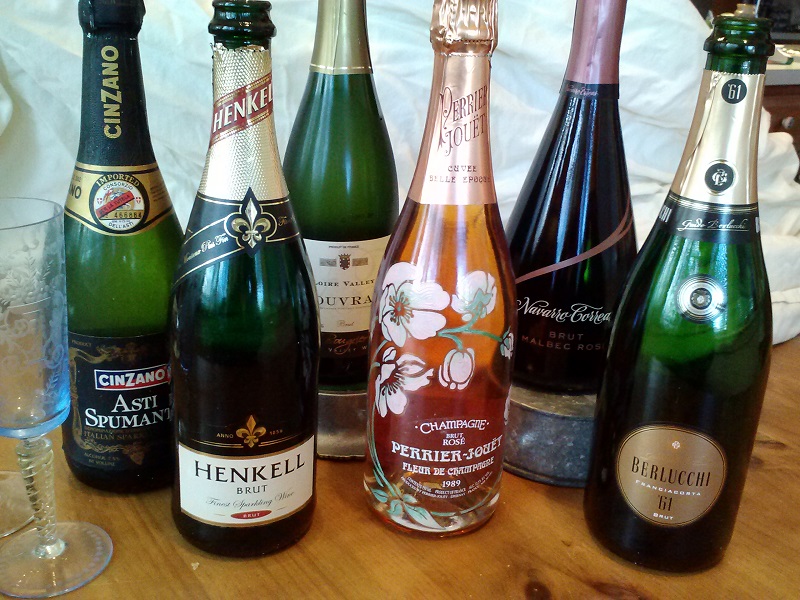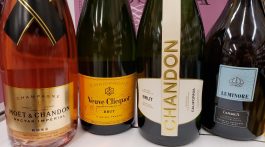Champagne – the wine of celebration! I’ll bet that you had a glass of bubbly for a toast to welcome the New Year – it’s a grand tradition. Birthdays, anniversaries, promotions, achievements – they’re all marked with a glass of sparkling wine – and why not? Delightful with appetizers and great at the table with a broad range of foods, sparkling wine’s brisk acidity, fresh-fruit aromas, full-bodied flavor and affordability make it a versatile food-friendly drink. We should be drinking more!
Sparkling is actually the correct term for bubbly wine. Only wine that comes from the Champagne region in the north of France can legally be called Champagne according to French law. The Champenoises are eager to defend their name in the courts of the world.
Sparkling wines, made elsewhere in France and around the world, are generally named after the place they are made or a well-established brand: Saumur in France’s Loire Valley; Cava in Spain; Sekt in Germany; and Prosecco and Lambrusco (both grape varieties) and Asti Spumante in Italy. In California many of the major European brands like Chandon, Roederer, Mumm, and Gloria Ferrer have established wineries to make wine in the new world. Native wineries across the US make sparkling wine, too: Schramsberg, Iron Horse, J and Korbel in California; Gruet in New Mexico; Domaine Ste Michelle and Argyle in Washington; Thibaut-Janisson in Virginia; plus Clinton Vineyards and Lamoreaux Landing in New York. Russians have loved sparkling wine ever since the Tsars were infatuated with French culture and make a considerable amount for their own consumption.
Sparkling wine is most often made from Chardonnay and Pinot Noir grapes, sometimes with the addition of local varieties. Although Pinot Noir is usually associated with red wines, it is possible to make a white wine with Pinot Noir juice by fermenting it without its red skins. The major Champagne brands blend the juice to create a distinctive house style that tastes the same from year to year. Vintage Champagnes like Dom Perignon, on the other hand, are only made in the best growing years and will show some flavor differences from vintage to vintage.
Compared with still wines, making sparkling wine is quite a bit more complicated. The traditional process, known as the Champagne Method, involves blending the grape juice; bottle fermentation which makes the wine fizzy; forcing the yeast sediment to the neck of the bottle by turning and tipping the bottle a little every day over six weeks (a process known as riddling); disgorging the sediment by freezing it in the neck of the bottle then opening it so the frozen sediment pops out from the pressure of the carbonation; adding back a little wine to refill the bottle (known as a dosage – pronounced like massage) and then aging again. No wonder it’s expensive!
Some of this labor-intensive process can be streamlined, particularly the hand riddling.
There are three main ways to make sparkling wine. The Champagne Method is the only one allowed in Champagne. Outside of Champagne cost-saving techniques can be applied or different methods used. In the Transfer Method, wine is fermented in the bottle, then transferred to a tank to  be filtered, dosaged and then rebottled, eliminating the expensive riddling. This difference can be expressed on the label as “fermented in THIS bottle” (Champagne Method) or “fermented in THE bottle” Transfer Method. The Charmat Process involves fermenting the wine in pressurized tanks to achieve carbonation and then bottling it – a much less expensive method.
be filtered, dosaged and then rebottled, eliminating the expensive riddling. This difference can be expressed on the label as “fermented in THIS bottle” (Champagne Method) or “fermented in THE bottle” Transfer Method. The Charmat Process involves fermenting the wine in pressurized tanks to achieve carbonation and then bottling it – a much less expensive method.
Most sparkling wine is white – the driest classified by the French as brut. Wines labeled extra dry are a little sweeter, and sec sweeter still. Wines with some sweetness used to be much more popular, but now you see mostly brut. Asti Spumante is a traditionally sweet Italian sparkling wine with a lovely fragrance of strawberries. Some rosé sparkling wine is made – it’s pretty color making it more festive. Very little sparkling red is made and what you find is mostly Lambrusco.
Sparkling wines are available at all price levels. True Champagne has the most labor-intensive process, is coveted around the world, marketed intensively with a heavy dose of prestige, and naturally commands the top prices. Basic bottles of major brands will start around $40.00. The sky’s the limit for prestige and vintage bottlings like Dom Perignon or Crystal.
 There are, however great deals to be found in other areas of the world. I recently enjoyed Berlucchi Cuvée ‘61 (non vintage), an Italian sparkler from Lombardy made with the traditional chardonnay and Pinot Noir grapes; fermented in the bottle with the metodo classico; with floral and citrus bouquet, fresh flavors, and bracing acidity; it sells for about $20.00. Henkell Brut, sparkling wine from Germany, a mass-market brand there, is a delightful every day drink with a full bodied texture, lively carbonation and fresh apple flavors. Stew Leonard’s has it for $9.99 – quite a bargain. Italian Prosecco wines, lively and fresh with lighter carbonation, are widely available across a broad range of prices – most representing good value.
There are, however great deals to be found in other areas of the world. I recently enjoyed Berlucchi Cuvée ‘61 (non vintage), an Italian sparkler from Lombardy made with the traditional chardonnay and Pinot Noir grapes; fermented in the bottle with the metodo classico; with floral and citrus bouquet, fresh flavors, and bracing acidity; it sells for about $20.00. Henkell Brut, sparkling wine from Germany, a mass-market brand there, is a delightful every day drink with a full bodied texture, lively carbonation and fresh apple flavors. Stew Leonard’s has it for $9.99 – quite a bargain. Italian Prosecco wines, lively and fresh with lighter carbonation, are widely available across a broad range of prices – most representing good value.
Sparkling wine is great for everyday drinking. The refreshing carbonation, bright acidity and fruit flavors make it a good companion to almost any food. While we tend to think of sparkling wine a special occasion drink or brunch quaff, in Europe its routinely available. If you ask for a glass of wine in a café , the likely response is, “red, white or sparkling?”
With the abundance of good and reasonably priced sparkling wines, it should be a regular part of our wine options. Here’s a toast to that!











No Comment